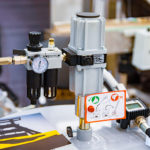Contributed by Mike Kreklau, Technical Sales at Tsunami Compressed Air Solutions Downtime and inefficiency don’t have to be your production line’s worst enemy. You want shop equipment that comes with no strings attached — no downtime and no maintenance. Maybe that’s a pipe dream, but there are ways to fix many air-related symptoms of an inefficient […]
Engineering Basics
How to select the right interchangeable pneumatic actuator
Contributed by Troy Sanders | National Sales Manager | Fabco-Air When your operation calls for a pneumatic actuator, you’ll find a wide range of products available from various manufacturers. But because no two applications are alike, you must weigh several considerations before selecting and ordering an actuator. This article will discuss the different cylinder types […]
Where are electropneumatic flow controllers used?
By Justin Fluegel, Contributor Flow in a fluid power system is synonymous with the velocity of an actuator. Electro-pneumatic flow control valves are used in applications where it is important to control the revolutions per minute of a pneumatic motor or speed of the linear actuator in machinery, such as this plastic roll machine. Both […]
Where are electropneumatic pressure regulators/controllers used?
By Justin Fluegel, Contributor Electropneumatic pressure regulators are commonly used to control the force, tension or torque output of an actuator in a machine. These are found in a wide range of applications from custom machinery, food processing, semiconductors, cyclic testing machinery, and welding applications. The breadth of opportunities is vast for this technology, given […]
How do electropneumatic pressure regulators/controllers work?
Some electropneumatic pressure regulators work by combining three important elements: the mechanical valve, the solenoid, and the controller. The mechanical valve is comprised of the valve body, spring, and spool. The valve body is typically machined from aluminum or brass. It includes a port for the unregulated air to enter the valve. Internally machined is […]
What are electropneumatic flow controllers?
An electropneumatic flow controller provides precision control of the flow of a gas to an actuator — representing the latest flow control option. They are most commonly used to control the flow of air to an actuator; thereby controlling the speed which the actuator extends/retracts or rotates. To appreciate the advances that electropneumatic flow valves […]
What is compressed air’s water carrying capacity?
If experiencing troublesome “water in the compressed air” problems, it often helps to understand the moisture carrying capabilities of compressed air. A rule of thumb is often used to help understand the effect of temperature on the water content of saturated compressed air. The rule states: “At 100 psi, every 20° F increase in air […]
What are electropneumatic pressure regulators/controllers?
By Justin Fluegel, Contributor A simple example of explaining a self-relieving pressure regulator is to imagine having a balloon with two normally closed ends. Call the ends supply and exhaust. Assume the balloon is empty and you ask for more pressure in the balloon. The supply end opens until the balloon pressure equals the requested […]
How do you control pressure in a pneumatic circuit?
Pressure regulators, as the name indicates, control the pressure in a pneumatic circuit. Setting and maintaining pressure in a system is important for safety and energy efficiency of individual actuators, tools and instruments as well as for the complete circuit. A typical manufacturing facility has plant air pressure from the compressor set to around 110 […]
Where are single-acting pneumatic cylinders used?
By Frances Richards, contributor Pneumatic cylinders are a clean and cost-effective option for achieving reliable linear motion in many industrial environments. Because they are lighter weight and lower maintenance than their hydraulic and electric counterparts, they are an excellent choice in applications from factory automation and transportation to packaging and life sciences. Two main styles […]










